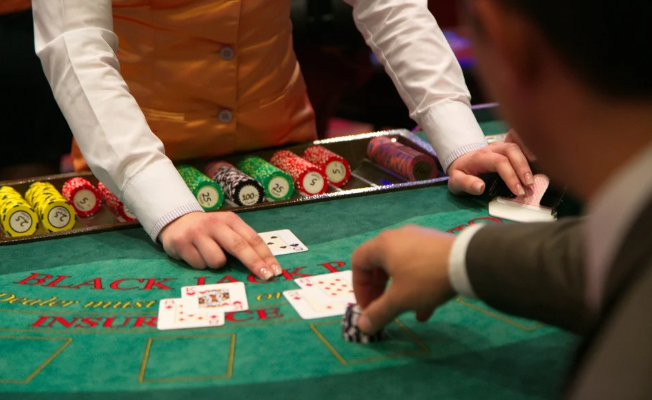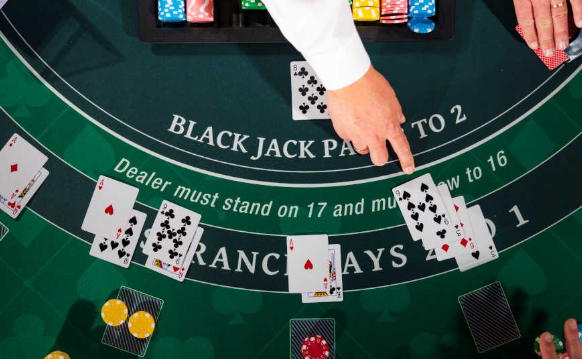Nearly every popular casino game comes with its own unique jargon, and learning this lingo is key to feeling confident at the table. When it comes to blackjack, players need to understand not just the terminology, but also the specific hand signals used during gameplay.
Because blackjack offers players multiple decision options, clear and consistent communication is essential. Fortunately, the system of table signals and communication is simple—easy enough for even complete beginners to learn quickly.
Why Are Hand Signals Used in Blackjack?
Hand signals in blackjack—like when a dealer swipes the table—serve several practical purposes. Most importantly, they create a verifiable visual record of a player’s decisions. If there’s ever a dispute over a player’s action, casino security can review video footage to confirm what was intended.
Hand signals also make the game more inclusive for players with hearing difficulties and help speed up gameplay. Most critically, they cut through the noise of a busy casino floor, eliminating the need for players to shout and helping dealers avoid confusion.
What Are the Standard Blackjack Hand Signals?

Getting comfortable with blackjack hand signals is an important step toward playing the game confidently at a casino. While these signals may vary slightly between regions and different blackjack variations, the core concepts are consistent enough to learn easily.
Take the split signal, for example: players typically place an additional stack of chips equal to their original bet next to the first, then hold up two fingers to indicate a split. In contrast, the surrender move has less standardized signaling—most players choose to announce it verbally to avoid any confusion.
That said, some players use a horizontal swipe of the finger behind their chips to signal surrender. Here are a few more common hand signals you’ll encounter at the table:
Double Down: Place an additional stack of chips (equal to your original bet) beside your existing wager. Some players reinforce this by tapping a finger on the table or holding up a single index finger, but simply adding the chips is usually enough.
Hit: In face-down games, scrape your index finger toward you across the table. In face-up games, tap the table lightly with your index finger.
Stand: For face-down games, tuck your cards under your chips without disturbing the chips. In face-up games, wave your hand palm-down over your cards to signal that you’re standing.
These gestures are part of standard casino procedure and help ensure smooth communication between players and dealers. Being familiar with them goes a long way toward improving your experience at the table.
Are Hand Signals Required in Blackjack?
Although using hand signals isn’t strictly mandatory, they are strongly encouraged. If you forget to use them, a dealer will usually give you a polite reminder rather than penalize you. However, learning and using proper signals is considered good etiquette—it keeps the game running smoothly and avoids misunderstandings.
If you’re new to casino blackjack, one helpful tip is to practice the gestures while playing online. Even though online games don’t require physical signals, mimicking them can help reinforce the actions and build your confidence for in-person play.
What About Live Dealer Blackjack?
In live dealer blackjack games, you can see the dealer’s actions in real time via video stream—but they can’t see you. As a result, physical hand signals have no role in this format. Instead, all your decisions—hit, stand, double, split, and surrender—are made through the on-screen interface. Most platforms also offer a chat function for communicating with the dealer or other players.
Even though hand signals aren’t needed in live dealer blackjack, there are still etiquette rules that help keep the game enjoyable for everyone.
Extra Etiquette Rules for Live Dealer Blackjack

Blackjack etiquette helps ensure a smooth, enjoyable experience for everyone at the table, including both players and dealers. While newcomers might not be familiar with all the unwritten rules, most of them simply come down to common courtesy and mutual respect.
To maintain fairness and transparency, players should avoid touching the cards in face-up games. In face-down versions, always handle the cards with just one hand—never two.
Similarly, once you’ve placed your bet and the dealer has called “no more bets,” you should not touch your chips. It’s also considered good form to stack your chips with the smaller denominations on top to make their value clear.
Etiquette also applies to how you interact with others at the table. It’s important to be polite, keep the mood positive, and avoid offering unsolicited advice to fellow players—even if you mean well.
And finally, when you’re ready to leave the table, consider tipping the dealer. Their role is vital in creating a fun and professional gaming experience, and a tip is a simple way to show appreciation for their service.


